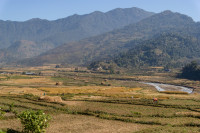Opinion
Folly at Nijgadh
The gigantic airport can be built in non-ecological zones instead of dense Sal forests
Roshan Sharma
Nepal is not only rich in biodiversity, but is also a global leader in nature conservation. In general terms, biodiversity means a variety of plants, animals and microbes from genes to ecosystems. The country has a record of accomplishments in increasing the populations of some critically endangered mammals like the tiger and one-horned rhinoceros, and is a pioneer in community-based conservation. However, our reputation as a global leader in biodiversity conservation is threatened, and we may become known as a reckless exploiter. The planned construction of an 8,000-hectare airport in Nijgadh, Bara, amid a landscape rich in biological diversity is testimony to this trend. The proposed area of the airport is equivalent to approximately 11,300 football fields.
Not only loss of trees
When large infrastructures like airports are developed in sensitive ecological zones, the result is loss of biodiversity due to habitat loss, fragmentation and wildlife fatalities due to vehicular accidents and noise pollution. While discussions on the ecological impacts have been focused only on felling Sal trees, I overlaid species habitat maps derived from the International Union for Conservation of Nature over the proposed airport site and found that 90 species of mammals may be directly affected by the construction. Among them, five are endangered and one is critically endangered. Many other birds and reptiles may also be affected. However, a more detailed analysis is required to assess the ecological impacts.
Infrastructure development is an important catalyst for the economic development of any country, but it should not be implemented in a way that results in huge ecological cost and loss of species. Ecological damage is often irreversible. This means that they should be constructed only when absolutely necessary and not in areas with biological importance. In places where infrastructure development is unavoidable, it should be built on minimum land so that biodiversity impact is low. In addition, a detailed assessment of biodiversity impacts should be carried out so that appropriate restoration and offset measures can be taken to compensate for the loss (or ideally to achieve a net gain of biodiversity). Unfortunately, none of these factors have been considered in planning the new airport. The hasty step towards reckless destruction of forests in the name of the Nijgadh Airport has raised several issues.
First, it is not quite clear why we need four international airports in a small country like Nepal. Two big airports are already planned in Pokhara and Bhairahawa. If the logic behind building Nijgadh Airport is that we need an international airport to complement Kathmandu’s congested Tribhuvan International Airport, why not extend or even rehabilitate it? If another international airport is absolutely necessary for a geopolitical reason, why has it been planned to be built amid the dense forests of Bara and why not in other non-ecological zones?
Second, it is also not clear why we need an airport of such a gargantuan size. A quick Google search of the world’s largest and busiest airports shows that Nijgadh Airport will be by far the largest in size. The world’s busiest airport—Hartsfield-Jackson Atlanta International Airport in the US—handled about 103 million travellers in 2017, but it is spread over only 1,902 hectares. This means that Nijgadh will be almost four times larger than the world’s busiest airport. Are we assuming that our airport will be busier than the 10 busiest airports in the world? Say we expect traffic at Nijgadh to be greater than at these hubs, wouldn’t it be more sensible to build an airport of around the same size? In my opinion, it makes neither economic sense (high expense to manage a large airport) nor ecological sense (destruction of nature and natural resources).
Third, to my knowledge, no assessment of the airport’s impact on the biodiversity in the region has been done. The environmental impact assessment (EIA) report of the airport only talks about the loss of trees and does not include any detailed assessment of the impacts on biodiversity. Stakeholders need to understand that replacing trees as proposed in the EIA report doesn’t compensate for the loss of biodiversity. Any biodiversity offsetting plan should consider the composition of species, vegetation structure, ecosystem processes and functions, and the people’s use of biological diversity, and for this, a detailed assessment of the impact of biodiversity needs to be done.
Minimise the impact
Nepal lies close to the bottom of the global list when it comes to poverty indices, such as Human Development Index (HDI) and Gross Domestic Product (GDP). Certainly, infrastructure development brings prospects for accelerating economic growth and alleviating poverty, but it should be planned to minimise the impact on the environment and biodiversity. In fact, if properly planned, infrastructure development can reduce human pressure on forest margins and other ecological zones, and thus prevent degradation. I call upon the relevant conservation organisations, government ministries and international development partners to strengthen policy support to avoid, or at least minimise, infrastructure development in critical habitats and ecological zones to avoid this massacre of a biological corridor.
Sharma is a Researcher at RMIT University, Melbourne, Australia.




 10.12°C Kathmandu
10.12°C Kathmandu










